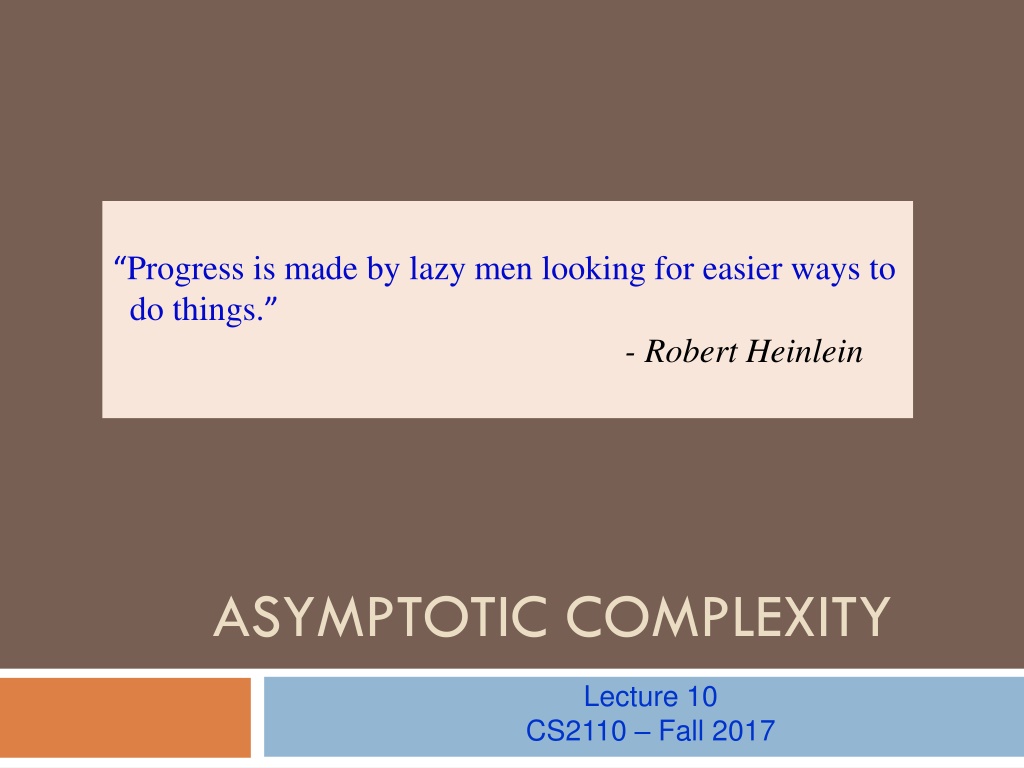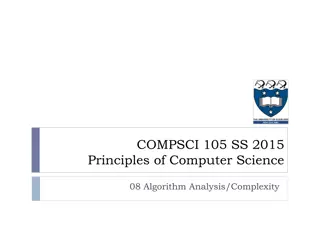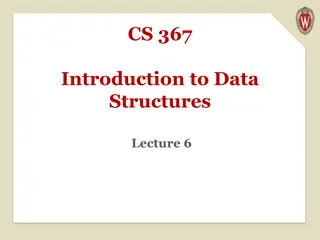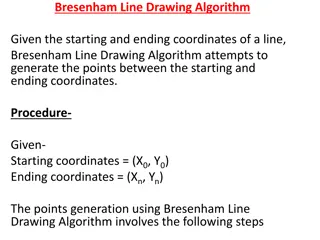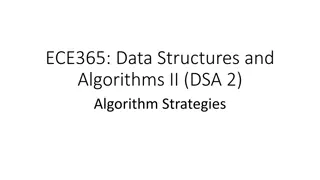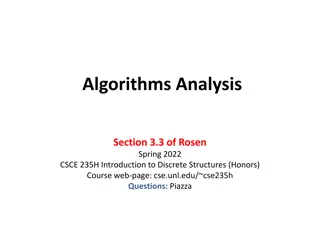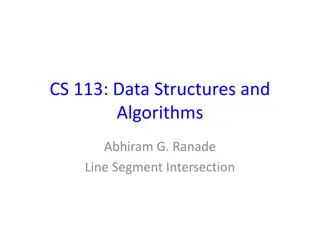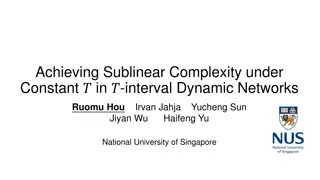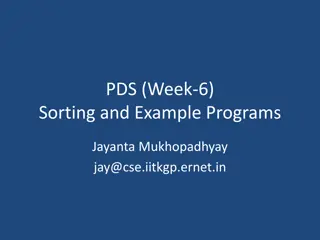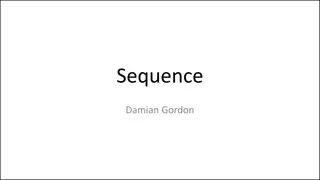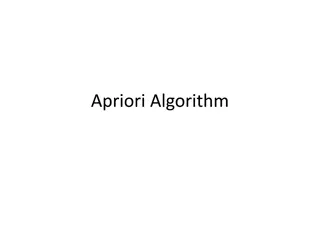Understanding Algorithm Efficiency and Complexity
Exploring the importance of simplicity, efficiency, and correctness in algorithms. Learn about basic steps, counting steps, and operations that affect algorithm speed. Discover key factors in determining algorithm superiority. Dive into the world of algorithmic efficiency without compromising on functionality.
Uploaded on Sep 26, 2024 | 0 Views
Download Presentation

Please find below an Image/Link to download the presentation.
The content on the website is provided AS IS for your information and personal use only. It may not be sold, licensed, or shared on other websites without obtaining consent from the author. Download presentation by click this link. If you encounter any issues during the download, it is possible that the publisher has removed the file from their server.
E N D
Presentation Transcript
Progress is made by lazy men looking for easier ways to do things. - Robert Heinlein ASYMPTOTIC COMPLEXITY Lecture 10 CS2110 Fall 2017
Announcements 2 90 80 70 60 50 40 30 20 10 0 <1 1 2 3 4 5 6 7 8 9 10 11 12 13 14 15 16 A3 due Friday Prelim next Thursday Prelim conflicts: fill out CMS by Friday Review section on Sunday A2
What Makes a Good Algorithm? 3 Suppose you have two possible algorithms that do the same thing; which is better? What do we mean by better? Faster? Less space? Easier to code? Easier to maintain? Required for homework? FIRST, Aim for simplicity, ease of understanding, correctness. SECOND, Worry about efficiency only when it is needed. How do we measure speed of an algorithm?
Basic Step: one constant time operation 4 Constant time operation: its time doesn t depend on the size or length of anything. Always roughly the same. Time is bounded above by some number Basic step: Input/output of a number Access value of primitive-type variable, array element, or object field assign to variable, array element, or object field do one arithmetic or logical operation method call (not counting arg evaluation and execution of method body)
Counting Steps 5 Statement: sum= 0; k= 1; k <= n k= k+1; sum= sum + k; Total steps: # times done 1 1 n+1 n n 3n + 3 // Store sum of 1..n in sum sum= 0; // inv: sum = sum of 1..(k-1) for (int k= 1; k <= n; k= k+1){ sum= sum + k; } 350 Linear algorithm in n All basic steps take time 1. There are n loop iterations. Therefore, takes time proportional to n. 300 250 200 150 100 50 0 0 20 40 60 80 100
Not all operations are basic steps 6 Statement: s= ""; k= 1; k <= n k= k+1; s= s + 'c'; Total steps: # times done 1 1 n+1 n n 3n + 3 // Store n copies of c in s s= ""; // inv: s contains k-1 copies of c for (int k= 1; k <= n; k= k+1){ s= s + 'c'; } Concatenation is not a basic step. For each k, catenation creates and fills k array elements.
String Concatenation 7 s= s + c ; is NOT constant time. It takes time proportional to 1 + length of s s String@00 String@90 String String b b char[] char[] char[]@018 char[]@02 char[] char[] 0 d 1 x 2 c 0 d 1 x
Not all operations are basic steps 8 Statement: s= ""; k= 1; k <= n k= k+1; s= s + 'c'; Total steps: Total steps: Statement: s= ""; k= 1; k <= n k= k+1; s= s + 'c'; n*(n-1)/2 + 2n + 3 # times # steps 1 1 1 1 n+1 1 n 1 n k # times done 1 1 n+1 n n 3n + 3 // Store n copies of c in s s= ""; // inv: s contains k-1 copies of c for (int k= 1; k <= n; k= k+1){ s= s + 'c'; } 350 Quadratic algorithm in n Concatenation is not a basic step. For each k, catenation creates and fills k array elements. 300 250 200 150 100 50 0 0 20 40 60 80 100
Linear versus quadractic 9 // Store n copies of c in s s= ; // inv: s contains k-1 copies of c for (int k= 1; k <= n; k= k+1) s= s + c ; // Store sum of 1..n in sum sum= 0; // inv: sum = sum of 1..(k-1) for (int k= 1; k <= n; k= k+1) sum= sum + n Linear algorithm Quadratic algorithm In comparing the runtimes of these algorithms, the exact number of basic steps is not important. What s important is that One is linear in n takes time proportional to n One is quadratic in n takes time proportional to n2
Looking at execution speed 10 Number of operations executed 2n+2, n+2, n are all linear in n, proportional to n 2n + 2 ops n*n ops n + 2 ops n ops Constant time size n of the array 0 1 2 3
What do we want from a definition of runtime complexity ? 11 1. Distinguish among cases for large n, not small n Number of operations executed 2. Distinguish among important cases, like n*n basic operations n basic operations log n basic operations 5 basic operations n*n ops 2+n ops 3. Don t distinguish among trivially different cases. 5 or 50 operations n, n+2, or 4n operations 5 ops size n of problem 0 1 2 3
"Big O" Notation 12 Formal definition: f(n) is O(g(n)) if there exist constants c > 0 and N 0 such that for all n N, f(n) c g(n) Get out far enough (for n N) f(n) is at most c g(n) c g(n) f(n) Intuitively, f(n) is O(g(n)) means that f(n) grows like g(n) or slower N
Prove that (n2 + n) is O(n2) 13 Formal definition: f(n) is O(g(n)) if there exist constants c > 0 and N 0 such that for all n N, f(n) c g(n) Example: Prove that (2n2 + n) is O(n2) Methodology: Start with f(n) and slowly transform into c g(n): Use = and <= and < steps At appropriate point, can choose N to help calculation At appropriate point, can choose c to help calculation
Prove that (n2 + n) is O(n2) 14 Formal definition: f(n) is O(g(n)) if there exist constants c > 0 and N 0 such that for all n N, f(n) c g(n) Example: Prove that (2n2 + n) is O(n2) f(n) = <definition of f(n)> 2n2 + n <= <for n 1, n n2> 2n2 + n2 = <arith> 3*n2 = <definition of g(n) = n2> 3*g(n) Transform f(n) into c g(n): Use =, <= , < steps Choose N to help calc. Choose c to help calc Choose N = 1 and c = 3
Prove that 100 n + log n is O(n) 15 Formal definition: f(n) is O(g(n)) if there exist constants c > 0 and N 0 such that for all n N, f(n) c g(n) f(n) = <put in what f(n) is> 100 n + log n <= <We know log n n for n 1> 100 n + n = <arith> 101 n = <g(n) = n> 101 g(n) Choose N = 1 and c = 101
O() Examples 16 Let f(n) = 3n2 + 6n 7 f(n) is O(n2) f(n) is O(n3) f(n) is O(n4) p(n) = 4 n log n + 34 n 89 p(n) is O(n log n) p(n) is O(n2) h(n) = 20 2n + 40n h(n) is O(2n) a(n) = 34 a(n) is O(1) Only the leading term (the term that grows most rapidly) matters If it s O(n2), it s also O(n3) etc! However, we always use the smallest one
Do NOT say or write f(n) = O(g(n)) 17 Formal definition: f(n) is O(g(n)) if there exist constants c > 0 and N 0 such that for all n N, f(n) c g(n) f(n) = O(g(n)) is simply WRONG. Mathematically, it is a disaster. You see it sometimes, even in textbooks. Don t read such things. Here s an example to show what happens when we use = this way. We know that n+2 is O(n) and n+3 is O(n). Suppose we use = n+2 = O(n) n+3 = O(n) But then, by transitivity of equality, we have n+2 = n+3. We have proved something that is false. Not good.
Problem-size examples 18 Suppose a computer can execute 1000 operations per second; how large a problem can we solve? operations 1 second 1 minute 1 hour n 1000 140 31 18 10 9 60,000 4893 244 144 39 15 3,600,000 200,000 1897 1096 153 21 n log n n2 3n2 n3 2n
Commonly Seen Time Bounds 19 O(1) O(log n) O(n) O(n log n) O(n2) O(n3) O(2n) constant logarithmic linear n log n quadratic cubic exponential excellent excellent good pretty good maybe OK maybe OK too slow
Big O Poll 20 Consider two different data structures that could store your data: an array or a doubly-linked list. In both cases, let n be the size of your data structure (i.e., the number of elements it is currently storing). What is the running time of each of the following operations: a get(i) using an array get(i) using a DLL insert(v) using an array insert(v) using a DLL
Java Lists 21 java.util defines an interface List<E> implemented by multiple classes: ArrayList LinkedList
Search for v in b[0..] 22 // Store in i the index of the first occurrence of v in array b // Precondition: v is in b. Methodology: 1. Define pre and post conditions. 2. Draw the invariant as a combination of pre and post. 3. Develop loop using 4 loopy questions. Practice doing this!
Search for v in b[0..] 23 // Store in i the index of the first occurrence of v in array b // Precondition: v is in b. 0 b.length v in here Methodology: 1. Define pre and post conditions. 2. Draw the invariant as a combination of pre and post. 3. Develop loop using 4 loopy questions. pre:b 0 i b.length post:b != v v ? 0 i b.length inv:b != v v in here Practice doing this!
The Four Loopy Questions 24 Does it start right? Is {Q} init {P} true? Does it continue right? Is {P && B} S {P} true? Does it end right? Is P && !B => R true? Will it get to the end? Does it make progress toward termination?
Search for v in b[0..] 25 // Store in i the index of the first occurrence of v in array b // Precondition: v is in b. 0 b.length v in here i= 0; pre:b while ( ) { b[i] != v i= i+1; 0 i b.length post:b != v v ? } 0 i b.length Each iteration takes constant time. Worst case: b.length-1 inv:b != v v in here iterations Linear algorithm: O(b.length)
Search for v in sorted b[0..] 26 // Store in i to truthify b[0..i] <= v < b[i+1..] // Precondition: b is sorted. 0 b.length sorted Methodology: 1. Define pre and post conditions. 2. Draw the invariant as a combination of pre and post. 3. Develop loop using 4 loopy questions. pre:b 0 i b.length post:b <= v > v 0 i k b.length inv:b <= v > v sorted Practice doing this!
Another way to search for v in b[0..] 27 // Store in i to truthify b[0..i] <= v < b[i..] // Precondition: b is sorted. i= -1; k= b.length; 0 b.length sorted pre:b while ( ) { i < k-1 int j= (i+k)/2; // i < j < k if (b[j] <= v) i= j; else k= j; 0 i b.length post:b <= v > v 0 i k b.length inv:b <= v > v sorted } 0 i j k b.length b <= v > v j = (i+k)/2
Another way to search for v in b[0..] 28 // Store in i to truthify b[0..i] <= v < b[i..] // Precondition: b is sorted. i= -1; k= b.length; 0 b.length sorted pre:b while ( ) { i < k-1 int j= (i+k)/2; // i < j < k if (b[j] <= v) i= j; else k= j; 0 i b.length post:b <= v > v 0 i k b.length inv:b <= v > v sorted } Each iteration takes constant time. Worst case: log(b.length) Logarithmic: O(log(b.length)) iterations
Another way to search for v in b[0..] 29 // Store in i to truthify b[0..i] <= v < b[i+1..] // Precondition: b is sorted. i= 0; k= b.length; 0 b.length ? This algorithm is better than binary pre:b searches that stop when v is found. 1. Gives good info when v not in b. while ( ) { i < k-1 int j= (i+k)/2; // i < j < k if (b[j] <= v) i= j; else k= j; 0 i b.length 2. Works when b is empty. post:b < ? 3. Finds last occurrence of v, not ? 0 i j k b.length arbitrary one. inv:b < ? 4. Correctness, including making progress, easily seen using invariant ? } Logarithmic: O(log(b.length))
Dutch National Flag Algorithm Dutch national flag. Swap b[0..n-1] to put the reds first, then the whites, then the blues. That is, given precondition Q, swap values of b[0.n] to truthify postcondition R: 0 n Q: b ? 0 n R: b reds whites blues 0 n P1: b reds whites blues ? 0 n P2: b reds whites ? blues
Dutch National Flag Algorithm: invariant P1 0 n h= 0; k= h; p= k; while ( ) { p != n if (b[p] blue) else if (b[p] white) { swap b[p], b[k]; p= p+1; k= k+1; Q: b ? 0 n p= p+1; R: b reds whites blues 0 n h k p P1: b reds whites blues ? } else { // b[p] red swap b[p], b[h]; swap b[p], b[k]; p= p+1; h=h+1; k= k+1; } }
Dutch National Flag Algorithm: invariant P2 0 n h= 0; k= h; p= n; while ( ) { k != p Q: b ? 0 n R: b reds whites blues if (b[k] white) else if (b[k] blue) { p= p-1; swap b[k], b[p]; k= k+1; 0 n h k p P2: b reds whites ? blues } else { // b[k] is red swap b[k], b[h]; h= h+1; k= k+1; } } 33
Asymptotically, which algorithm is faster? 34 Invariant 1 Invariant 2 0 h k p n 0 h k p n reds whites blues ? reds whites ? blues h= 0; k= h; p= k; while ( ) { p != n h= 0; k= h; p= n; while ( ) { if (b[k] white) else if (b[k] blue) { p= p-1; swap b[k], b[p]; k != p k= k+1; if (b[p] blue) else if (b[p] white) { swap b[p], b[k]; p= p+1; k= k+1; p= p+1; } else { // b[k] is red swap b[k], b[h]; h= h+1; k= k+1; } else { // b[p] red swap b[p], b[h]; swap b[p], b[k]; p= p+1; h=h+1; k= k+1; } } } }
Asymptotically, which algorithm is faster? 35 Invariant 1 Invariant 2 0 h k p n 0 h k p n reds whites blues ? reds whites ? blues h= 0; k= h; p= k; while ( ) { p != n might use 2 swaps per iteration h= 0; k= h; p= n; while ( ) { k != p uses at most 1 swap per iteration if (b[p] blue) else if (b[p] white) { swap b[p], b[k]; p= p+1; k= k+1; These two algorithms have the same asymptotic running time (both are O(n)) p= p+1; if (b[k] white) else if (b[k] blue) { p= p-1; swap b[k], b[p]; k= k+1; } else { // b[p] red swap b[p], b[h]; swap b[p], b[k]; p= p+1; h=h+1; k= k+1; } else { // b[k] is red swap b[k], b[h]; h= h+1; k= k+1; } } } }
